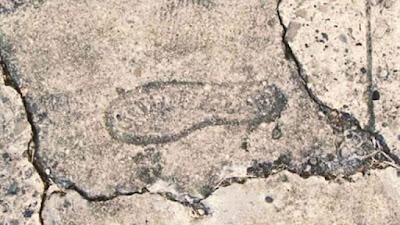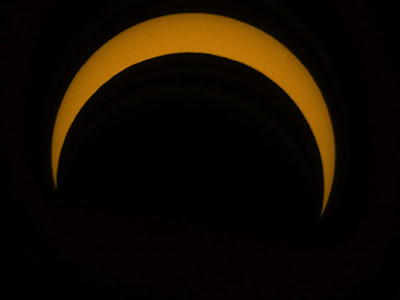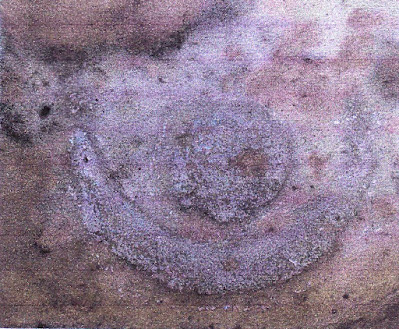The 2023 C.R.A.P. Award goes not to the people cited in the references below, but to the idea that they are pushing back against – supposed shoe tracks in Arizona that have been claimed to be many millions of years old by Creationists. Let me restate that, I am not criticizing the reports, I am criticizing the crazy ideas of fringie Creationists. These discoveries were supposedly made in the 1920s in Pershing County, Nevada. Reports are somewhat fuzzy since they state that the discoveries were found in a coal seam in Fisher Canyon yet the quote from the supposed discoverer states he found it on a hillside. I am going to visit reports on two different versions of the discovery. One individual who remains anonymous created a phony photograph of the footprint and put it up online – to him as an individual I award a special C.R.A.P. Award.
Creationists, the people who argue that human beings and dinosaurs co-existed, leap on misinterpretations and frauds such as this to try to prove their strange beliefs which they now often call ‘Creation Science.’
"Creation science rejects evolution and the common descent of all living things on Earth. Instead, it asserts that the field of evolutionarey biology is itself pseudoscientific or even a religion. Creationists argue instead for a system call baraminology, which considers the living world to be descended from uniquely created kinds or 'baramins.' Creation science incorporates the concept of catastrophism to reconcile current landforms and fossil distributions with Biblical interpretations, proposint the remains resulted from successive cataclysmic events, such as a worldwide flood and subsequent ice age. It rejects one of the fundamentral principles of modern geology (and of modern science generally), uniformitarianism, which applies the same physical and geological observed on the Earth today to interpret the Earth's geological history." (Wikipedia) They believe that early humans co-existed with dinosaurs - sort of like Alley Oop. So this quoted passage describes the fringies who believe in these things - now the the actual belief on shoeprints in Arizona many millions of years old, which is anything but science.
A 2006 report by Glen Kuban describes in detail the supposed discovery and provides an analysis of the claim. “A number of strict creationists and "ancient anomaly" enthusiasts have claimed that a "shoe print" was found in Triassic rock near Fisher Canyon, Pershing County, Nevada. Although most of these authors state that the print was found by John Reid in 1922 (or 1927 according to some), evidently it was actually found by Albert E. Knapp, an employee of Nevada Mining Company, on or before January 15th, 1917.” (Kuban 2006)
In 2021 Vicky Verma quoted the discoverer of the supposed footprint: “He wrote: ‘In descending the hill my attention was attracted by the fossil, which lay fossil side uppermost amongst some loose rocks. I picked it upl and put it in my pocket for further examination, and on such examination came to the conclusion that it is a layer from the heel of a show which had been pulled from the balance of the heel by suction; the rock being in a plastic state at the time. I found it in limestone of the Triassic period, a belt of which runs through that section of the hills.’ Later, Reid somehow took the fossilized shoeprint to New York and had it analyzed by a competent geologist of the Rockefeller Foundation, who verified Mr. Knapp and pronounced it unquestionably Triassic limestone.” (Verma 2021) Now we have to remember that this was 100 years ago, a time when the public was less informed about science. I am, however, mystified as to how a so-called geologist could have made such a misidentification.
“In 1922, two reports on the alleged shoeprint were published in the New York Times and the American Weekly section of the New York Sunday American respectively. According to the second report by W. H. Ballou, John T. Reid discovered the fossil (which was obviously a mistake). The report said: ‘Some time ago, while he was prospecting for fossils in Nevada, John T. Reid, a distinguished mining engineer, and geologist stopped suddenly and looked down in utter bewilderment and amazement at a rock near his feet. For there, a part of the rock itself was what seemed to be a human footprint! Closer inspection showed that it was not a mark of a naked foot, but was, apparently, a shoe sole which had been turned into stone. The forepart was missing. But there was the outline of at least two-thirds of it, and around this outline ran a well-defined sewn thread which had, it appeared, attached the welt to the sole. Further on was another line of sewing, and in the center, where the foot would have rested had the object really been a show sole, there was an indentation, exactly such as would have been made by the bone of the heel rubbing upon and wearing down the material of which the sole had been made. Thus was found a fossil which is the foremost mystery of science today. For the rock in which it was found is at least 5 million years old.” (Verma 2021)
Kuban is quite straightforward with his long and fair analysis and then his discounting of the claims. “The "Nevada shoe print" claims are not well supported by the available evidence. The footprint advocates have presumed that the missing portion of the object was very shoe-like in shape, whereas any number of other shapes are possible. They have not demonstrated that the supposed print was ever part of a striding sequence, or that it contains the detailed "stitching" features they assert. The present location of the object is unknown, impeding further study. Judging from the available photographs, the specimen is most likely a broken ironstone concretion, perhaps one that has suffered some erosion.” (Kuban 2006)
Photos of the 1920s ‘fossil’ clearly show a broken and eroded concretion. But the claim resurfaced recently with a much more convincing photograph of a shoe or bootprint in stone. This counterfeit seems to be the product of another Creationist fringie trying to strengthen their case. The more recent image appears to be a photographic manipulation of two negatives, one of a rock surface and the other one of a footprint. The fact it shows a tread pattern marks it a modern as prehistoric footwear did not have this typed of treads on the bottom of the sole. Online reports claiming the discovery of this second shoeprint seem to parrot the reports of the 1920s discovery but with the illustrations replaced with the newly counterfeited photograph.
On the subject of this new photograph – the counterfeited one – as a test I went to DALL-E-2 and asked it to make a picture of the tread marks of a boot print in the rock of a cliff face. This is my version of the counterfeited photograph. With a little more time and more specific instructions I am confident that DALL-E-2 and I could have made one much like the counterfeit shoe print.
I want to reiterate that this C.R.A.P. Award is not being awarded to the authors of the reports I cite below to whom I am grateful for the information, but to the fringies who believe this sort of thing. Whether it is petroglyphs of dinosaurs or the fossilized imprint of a shoe or boot wearing foot from 15 or 200 million years ago – absurd.
NOTE: Some images in this posting were retrieved from the internet with a search for public domain photographs. If any of these images are not intended to be public domain, I apologize, and will happily provide the picture credits if the owner will contact me with them. For further information on these reports you should read the original reports at the sites listed below.
REFERENCES:
Kuban, Glen J., 2006, Nevada Shoe Print?, http://paleo.cc/paluxy/nevada.htm. Accessed online 9 December 2023.
Verma, Vicky, 2021, Mystery of Alleged 200 Million-Year-Old Shoe Print Found in Nevada in 1917, https://www.howandwhys.com. Accessed online 9 December 2023.
Wikipedia, Creation Science, https://en.wikipedia.org/wiki/Creation_science. Accessed online 11 December 2023.







.jpg)



























%20by%20Jean%20Fouquet.%20Photo%20Credits%20Francesco%20Bini.jpg)







